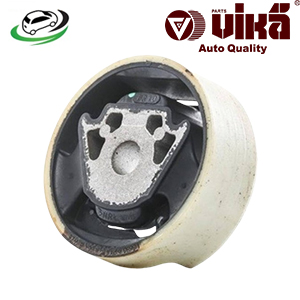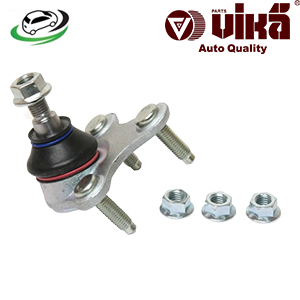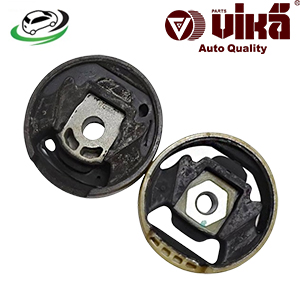-20%
Get Upper Engine Mount Audi A3 8P1/ A3 8PA / VW Touran 1T1/1T2/ Jetta 1K2/ Golf MKV/1K1/ Caddy 2CB/2CJ/2KB/2KJ 1K0199868
The upper engine mount, also known as the top engine mount or upper motor mount, is a critical component of a vehicle’s engine mounting system. It plays a vital role in securing the engine to the vehicle’s frame while helping to absorb vibrations, reduce noise, and maintain the engine’s alignment. Understanding the function, types, and importance of the upper engine mount, as well as recognizing signs of wear and the need for replacement, is essential for ensuring the smooth operation and longevity of your vehicle.
The Purpose of the Upper Engine Mount
The primary function of the upper engine mount is to securely hold the engine in place within the engine bay. This mount is strategically positioned to support the engine’s weight and resist the forces generated by engine operation. Specifically, the upper engine mount is responsible for:
- Engine Stabilization: The upper engine mount provides a secure attachment point for the engine, helping to stabilize it during acceleration, deceleration, and cornering. This stabilization is crucial for maintaining proper engine alignment and preventing excessive movement.
- Vibration Dampening: The engine generates significant vibrations during operation, which can be transmitted to the vehicle’s chassis and passenger cabin. The upper engine mount, typically constructed with a combination of metal and rubber or polyurethane, absorbs these vibrations, resulting in a smoother and quieter ride.
- Noise Reduction: By minimizing the transmission of engine vibrations to the vehicle’s body, the upper engine mount helps reduce noise levels inside the cabin. This contributes to a more comfortable driving experience.
- Protecting Other Components: By keeping the engine securely in place, the upper engine mount helps protect other components, such as the exhaust system, hoses, and wiring, from being damaged by excessive engine movement.
Types of Upper Engine Mounts
There are several types of engine mounts used in vehicles, each designed to meet specific performance and comfort requirements. The most common types of upper engine mounts include:
- Rubber Engine Mounts: Rubber mounts are the most traditional type of engine mount. They consist of a steel bracket with a rubber insert that absorbs vibrations and holds the engine securely in place. These mounts are commonly used in a wide range of vehicles due to their cost-effectiveness and ability to dampen vibrations.
- Hydraulic Engine Mounts: Hydraulic mounts contain a fluid-filled chamber within the rubber mount. The fluid, typically a type of hydraulic oil, enhances the mount’s ability to absorb vibrations and reduce noise. Hydraulic mounts are often used in luxury vehicles or vehicles where comfort is a priority.
- Polyurethane Engine Mounts: Polyurethane mounts are stiffer than rubber mounts and provide better resistance to wear and tear. They are often used in performance or racing vehicles where engine stability is more critical than vibration damping.
- Active Engine Mounts: Active engine mounts are equipped with electronic controls that adjust the damping characteristics based on driving conditions. These mounts are typically found in high-end vehicles and are designed to optimize both comfort and performance by adapting to different engine loads and speeds.
How the Upper Engine Mount Works
The upper engine mount functions by providing a secure connection between the engine and the vehicle’s frame. Its construction and placement allow it to perform several key functions:
- Damping Vibrations: The upper engine mount’s rubber, hydraulic, or polyurethane material absorbs vibrations generated by the engine, preventing them from being transmitted to the vehicle’s chassis. This results in a smoother ride with less noise and discomfort.
- Supporting Engine Weight: The upper engine mount plays a crucial role in supporting the engine’s weight, particularly the upper portion of the engine. This support helps balance the engine and ensures it remains properly positioned within the engine bay.
- Controlling Engine Movement: During acceleration, braking, and cornering, the engine experiences various forces that can cause it to move. The upper engine mount helps restrict this movement, keeping the engine stable and aligned. This stability is essential for maintaining the proper operation of the drivetrain and preventing damage to surrounding components.
- Isolating Noise: The upper engine mount also plays a role in isolating and reducing engine noise. By absorbing vibrations and preventing them from being transmitted to the vehicle’s body, the mount helps create a quieter cabin environment.
Signs of a Failing Upper Engine Mount
Over time, engine mounts can wear out or fail due to constant exposure to heat, vibration, and stress. Recognizing the signs of a failing upper engine mount is crucial for preventing further damage to the vehicle:
- Increased Vibrations: One of the most noticeable signs of a failing engine mount is an increase in vibrations felt inside the vehicle, especially during idling or acceleration. As the mount wears out, its ability to dampen vibrations diminishes, leading to a rougher ride.
- Excessive Engine Movement: If the upper engine mount is damaged, the engine may move excessively within the engine bay. This can cause clunking or knocking noises, particularly during acceleration, braking, or when shifting gears. In severe cases, the engine may even shift position, leading to misalignment of the drivetrain components.
- Unusual Noises: A failing upper engine mount can produce various noises, including knocking, clunking, or banging sounds. These noises are often more pronounced when the vehicle is accelerating, decelerating, or driving over uneven surfaces.
- Visible Wear and Tear: Upon visual inspection, a failing engine mount may show signs of wear, such as cracks, tears in the rubber, or fluid leaks (in the case of hydraulic mounts). If the mount is severely damaged, it may even appear deformed or broken.
- Engine Misalignment: A damaged upper engine mount can lead to misalignment of the engine and drivetrain components. This misalignment can cause issues such as uneven wear on the drivetrain, poor handling, and increased strain on other engine mounts.
Replacing a Failing Upper Engine Mount
Replacing a failing upper engine mount is a crucial maintenance task that should be performed as soon as signs of wear or damage are detected. The process typically involves the following steps:
- Lifting the Vehicle: The vehicle needs to be safely lifted using a jack and supported with jack stands. This allows access to the engine bay where the upper engine mount is located.
- Supporting the Engine: Before removing the old mount, the engine must be supported using an engine hoist or a jack with a wooden block to prevent damage. This step is crucial to avoid undue strain on the remaining engine mounts.
- Removing the Old Mount: The bolts securing the upper engine mount to the engine and the vehicle’s frame are removed. The old mount is then carefully taken out of its position.
- Installing the New Mount: The new upper engine mount is positioned and bolted securely in place. It’s important to ensure that the mount is properly aligned and that the bolts are tightened to the manufacturer’s specifications.
- Lowering the Vehicle: Once the new mount is installed, the engine is gently lowered back into place, and the vehicle is taken off the jack stands. A final check is performed to ensure everything is secure and properly aligned.
Importance of Timely Replacement
Replacing a worn or damaged upper engine mount is essential for maintaining the vehicle’s performance and preventing further issues. Neglecting this component can lead to several problems:
- Increased Wear on Other Mounts: A failing upper engine mount can place additional strain on the other engine mounts, leading to premature wear and potential failure of those mounts as well.
- Damage to Drivetrain Components: Excessive engine movement due to a failing mount can cause misalignment of the drivetrain components, leading to issues such as transmission damage, worn driveshafts, and increased wear on CV joints and axles.
- Decreased Comfort and Safety: A failing engine mount can significantly reduce the comfort of the ride by increasing vibrations and noise. In extreme cases, it can also affect the handling and safety of the vehicle.
- Potential Engine Damage: If the engine shifts position due to a failed mount, it can cause damage to critical components such as the exhaust system, radiator, and wiring harnesses. This can lead to costly repairs and increased downtime for the vehicle.
Follow us on Facebook for more parts.



